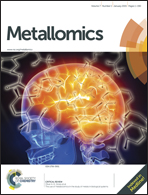What has fluorescent sensing told us about copper and brain malfunction?
Abstract
There is growing evidence that copper and copper-binding proteins are common denominators in the mechanisms of neurodegenerative diseases such as Alzheimer's and Parkinson's. These pathologies have been linked to changes in copper homeostasis, but the question of whether this is a causal or effective relationship remains unanswered. A clearer understanding will require a way to visualise copper at a molecular level in vivo. Fluorescent metal sensing is one such tool, and a number of Cu(I) probes have been reported with excellent sensing properties and complementary studies that validate their biological application. This review critically evaluates the recent progress in fluorescent copper sensing and suggests some new directions for future study of copper neurochemistry.

- This article is part of the themed collection: Alzheimer's Research Month 2016

 Please wait while we load your content...
Please wait while we load your content...